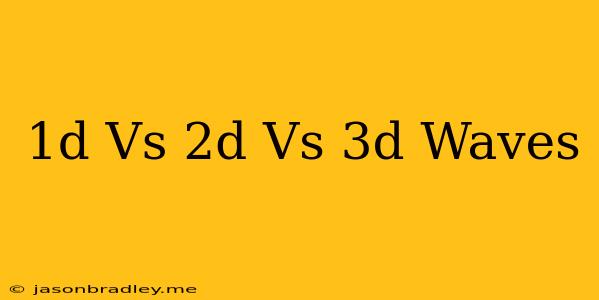1D vs 2D vs 3D Waves
Waves are ubiquitous in nature, from the ripples on a pond to the light that fills our world. They carry energy and information, and their behavior is governed by the principles of physics. To understand waves, it is essential to grasp the concept of dimensionality.
1D Waves: A Simple Journey
A one-dimensional (1D) wave propagates along a single line or direction. Imagine a string stretched taut and then plucked. The disturbance, a pulse, travels along the string, displacing the particles of the string up and down. This is a classic example of a 1D wave.
Key characteristics of 1D waves:
- Travel in one direction.
- Can be described by a single variable (e.g., position along the string).
- Examples: sound waves traveling through a straight pipe, pulses in a stretched string.
2D Waves: Spreading the News
Two-dimensional (2D) waves travel across a surface, spreading out in two directions. Imagine dropping a pebble into a still pond. The disturbance creates circular ripples that expand outward from the point of impact. These ripples are 2D waves.
Key characteristics of 2D waves:
- Travel across a surface.
- Can be described by two variables (e.g., x and y coordinates on the pond's surface).
- Examples: water waves on the surface of a lake, seismic waves traveling across the Earth's surface.
3D Waves: The Big Picture
Three-dimensional (3D) waves propagate through space, spreading out in all directions. Light waves are a prime example. They travel as electromagnetic waves, carrying energy and information from the sun to our eyes.
Key characteristics of 3D waves:
- Travel through space.
- Can be described by three variables (e.g., x, y, and z coordinates in space).
- Examples: light waves, sound waves in open air, electromagnetic waves.
Understanding the Differences: A Practical Perspective
The dimensionality of a wave influences its behavior. For instance, a 1D wave on a string can only travel along the string, while a 2D wave on a pond can spread out in all directions on the pond's surface. 3D waves like light can travel even further, reaching us from distant stars.
The dimensionality of a wave also affects its ability to interact with its surroundings. A 1D wave can only reflect off of a single point, while a 2D wave can reflect off of a line, and a 3D wave can reflect off of a surface.
By understanding the differences between 1D, 2D, and 3D waves, we can gain valuable insights into the nature of energy propagation and its interaction with our world.
